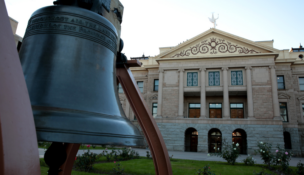Top 10 issues of the 2008 legislative session
Arizona Capitol Reports Staff//July 11, 2008//[read_meter]
Top 10 issues of the 2008 legislative session
Arizona Capitol Reports Staff//July 11, 2008//[read_meter]
Initiatives
Arizona voters will have plenty to consider in November, aside from helping to elect a president and federal and state lawmakers. Eleven ballot measures are expected to appear on the ballot statewide, and many of them promise to generate some hard-fought, bitter campaigns.
Punching through the noise of the McCain-Obama presidential race would be difficult at any time, but this year’s ballot initiative and referendum list definitely has the potential.
Voters will choose whether to amend state trust land law, increase the sales tax for transportation infrastructure, abolish affirmative-action policies for government hiring and contract awarding, amend employer sanctions, change real-estate and home-sales laws, allow payday loans to continue, constitutionally enshrine residents’ right to choose their own health care and constitutionally prevent gays from marrying.
Voters again will consider whether to raise legislators’ salaries to $30,000 from $24,000, and in many, but not all school districts, residents will vote on unification proposals.
What’s expected
Almost every interest under the sun is affected by the issues that will, barring successful lawsuits, appear on the 2008 ballot. Immigrant advocates, real estate professionals, gay-rights advocates, homebuilders, labor unions, doctors, patients, lawyers, limited government stalwarts, social conservatives, conservationists, school boards, ranchers, payday lenders, advocates for the poor, construction companies; you name it.
Education
For the most part, schools escaped unscathed from massive state budget cutbacks. And the money that was cut wasn’t intended for classroom instruction.
The largest single cut to education was a $39.3 million reduction in the amount of basic state aid projected in January. But that reduction in education spending is more a function of numbers than politics, as education officials say enrollment will be lower than originally expected when classes resume in the fall.
The reductions mostly impacted the actual classrooms, not the programs. More than $66 million was taken from a fund used for building maintenance, and the state reevaluated the number of schools it will need to build — based on the slower enrollment growth — and determined it could delay construction on projects totaling $187 million.
Despite the doom and gloom of budget cuts, schools were able to get help in dealing with the cost of excess utilities, which districts can pay for now through a property tax on residents. In a year, though, the districts’ ability to issue a special tax will be eliminated as a condition of Prop. 301 passed in 2000. Many of the districts that issue an excess utilities tax told lawmakers they feared having to take money from the classroom to cover energy costs.
To help the districts, two lawmakers drafted legislation that would have required the state pick up part of the tab for the excess utilities costs when the taxing ability expired. The bill being pushed by Sen. Barbara Leff, R-11, and Rep. Michele Reagan, R-8, was held up in the House by Majority Leader Tom Boone, but the language was included in the budget. Beginning in the 2010 fiscal year, the state will cover 90 percent of the excess utilities costs, and the districts will pick up the rest.
What’s expected
There aren’t many places in the K-12 education system the state can cut — even if the economy continues to decline and revenues don’t hit projected levels in the coming months — because the vast majority of the funding has been mandated by voters.
However, new programs or those that have been expanded in recent years are fair game and could be targeted. Those programs include full-day kindergarten and a statewide effort to attract more math and science students.
It’s also likely that lawmakers will again turn their attention to the brick-and-mortar funding if cuts need to be made. Building renewal money can be withheld again and Republicans probably will intensify their push for a complete moratorium on new school construction.
And if the economy continues its slide into the 2010 fiscal year, the excess utilities funding will be a prime target for Boone and others when lawmakers look for ways to trim government spending. School districts, he said, should have been working since 2000 to trim utility costs.
Immigration
Illegal immigration didn’t generate as many headlines this session as it had during other recent years. The only immigration-related issue of substance legislators addressed this year was a in a bill to clarify to the employer sanctions bill passed in 2007. That measure, H2745 (Laws 2008, Chapter 152), restricts penalties to businesses that knowingly hired illegal workers after the law went into effect, not retroactively as the law’s chief supporter had indicated.
Rep. Russell Pearce also included provisions to prevent prosecution of businesses that make “good faith” attempts to comply with state and federal hiring laws. Other provisions of the law, which went in to effect May 1, addressed some of the concerns outlined by a special panel of business representatives that had been formed last year by House Speaker Jim Weiers. Pearce also included language in his legislation that aimed to strengthen identity-fraud penalties and clamp down on the day-labor market.
The majority of the news surrounding immigration measures this year was focused on measures that failed to navigate the legislative process. The report created by the special committee was the impetus behind seven bills sponsored by Safford Republican Rep. Bill Konopnicki and Yuma Democrat Theresa Ulmer. While some of the ideas were folded into Pearce’s final bill — for instance, eliminating the law’s retroactivity — most were not, including attempts to ban anonymous complaints against businesses, remove a requirement that all businesses run new hires through the federal E-Verify database and require business owners to have “actual or constructive” knowledge before they can be prosecuted.
Also left unsettled at the end of the session was a state-level guest-worker program pushed by Konopnicki and Senate Minority Leader Marsha Arzberger. The measure would have allowed Arizona businesses to import workers from Mexico if employers could show there were no Americans willing to perform the jobs. Although the bill was supported by Weiers and Senate President Tim Bee, it stalled in the Senate after Lake Havasu City Republican Ron Gould threatened a filibuster if the bill was brought up for debate on the Senate floor.
What’s expected
Future legislative action on employer sanctions hinges on the success or failure of a ballot measure this fall. A coalition of businesses known as Wake Up Arizona is the primary backer of the Stop Illegal Hiring initiative, which asks voters to approve a new set of employer sanctions laws. The ballot proposition is more business-friendly than the existing law and incorporates many of the Konopnicki and Ulmer bills that critics say would neuter the state’s ability to sanction employers. If the ballot measure is approved by voters, it will be virtually impossible for the Legislature to amend because of voter protection.
As for other immigration-related legislation, Pearce likely will continue to push for laws requiring local law enforcement officers to enforce federal immigration laws. He was chairman of a failed effort to get such a proposal on the ballot this fall and sponsored a legislative measure that would have done the same this year.
Deficit
The deficit for the 2008 budget year grew from nearly $1 billion when the session began to about $1.5 billion by April, forcing legislators at that time to pass a quick fix before the end of the fiscal year on June 30.
The numbers for the 2009
budget were even worse: that shortfall grew from $1.5 billion to more than $2 billion as state revenues continued to fall short of projections. In the end, a budget was approved to deal with a deficit just under $2 billion, even though the latest projections from legislative analysts anticipated a $2.2 billion shortfall.
Gov. Janet Napolitano didn’t join talks on a 2008 budget fix until March, with only three months remaining in the fiscal year, but she ultimately got most of what she wanted. Neither the 2008 fix nor the 2009 budget made deep cuts into state programs; the two budgets collectively cut only about $650 million in state agency spending in solving a combined $3.5 billion in revenue shortfall.
Instead, the budget plans drained the state’s rainy day fund ($700 million), raided funds designated for specific programs ($636 million), borrowed to build new schools ($527 million) and deferred making two months of education payments to the following fiscal year ($660 million), among other things.
After calling for significant, permanent cuts in state spending, most Republicans stood opposed to the 2009 budget, which was negotiated by Senate President Bee, Napolitano, Democrat lawmakers and a handful of Republican legislators. Only eight of 50 Republican lawmakers voted to approve the budget.
What’s expected
A special session to revise the 2009 budget is likely, especially if the economy continues to flounder, many Republican lawmakers have said. The budget is already $300 million short, according to the latest revenue projections, and Republicans in general are skeptical the revenue forecasted in budget will actually be collected.
On top of that, lawmakers will be staring down a projected $1.3 billion deficit for the 2010 budget year.
Lawmakers will have few options left to deal with the 2010 deficit and any shortfall this year. The cash reserves are gone, borrowing won’t provide enough to bridge the gap, there aren’t many special funds left to sweep into the general fund, and delaying another month of education payments likely would be resisted by the schools.
The two most obvious solutions to any deficit would be to cut state spending and increase revenues by raising fees or taxes. A tax hike is not likely, as any revenue increase would need approval from a supermajority of representatives and senators. But it could prove equally difficult to solve a large deficit only by cutting spending.
Power struggles
The intra-caucus bickering in the House that dominated the 2007 session was largely subdued this year.
The cracks in the Democratic caucus appeared to be patched up and there were no open disputes, as the minority members stood firm in their support of social issues.
Among Republicans, the rumors of a leadership coup that dominated the end of 2007 all but disappeared in 2008, as House Speaker Jim Weiers worked to include some members in behind-the-scenes budget talks.
The real power struggle came at the end of the session, as Napolitano and legislative Democrats forged a budget pact with Senate President Bee and two other Republicans from each chamber. The group was able to wrest control of the process from the Republican majority.
The budget deal was vociferously opposed by the vast majority of GOP lawmakers, including House and Senate leaders, because they felt it included too few cuts, too many gimmicks and too much borrowing. But the bipartisan coalition was able to convince a handful of Republicans to support the budget, assuring its passage.
What’s expected
The sting of defeat is painful for Republicans who opposed the budget. Although some spent the final night of session joking about the tire tracks on their backs, others fumed. No doubt the more fiscally conservative wing of the party will place a heavy emphasis on targeting the Republicans some have called “turncoats” in this fall’s election — and next session, if those Republicans get the thumbs-up from voters.
But the retribution may be moot, as Democrats see what happened this year as an extension of the 2006 elections and a precursor for Nov. 4. The massive gains two years ago — especially in the House, where Democrats picked up six seats — allowed the minority party to exert some control on the proceedings this year. And Democrat lawmakers and strategists say the wave that swept out Republicans in 2006 still is growing and will result in the GOP losing control of the House for the first time since 1966.
Transportation
Toll road-related proposals went further this session than they did last year, but all three major measures aimed at clearing the way for some form of pay-to-use roads eventually ended up going nowhere, failing on the Senate floor or gathering dust in the House.
Some lawmakers, especially those originally from the East Coast and other regions where tolls are common, were wary about opening Arizona to a system of tolls.
“It’s outside the box a little bit. People just aren’t comfortable with it,” said Sen. Ron Gould, a supporter of toll roads.
It’s also a tough sell outside of the Legislature. A survey by the Northern Arizona University showed a majority of registered voters in Arizona do not see toll roads as a solution. Instead, more than half of respondents said they are likely to vote for a tax increase to pay for road maintenance and construction if the question appeared on the 2008 ballot.
But Gould and others see a silver lining: The proposals are at least stimulating public debate. That debate is part of an ongoing discussion about where to get the money to expand the state’s clogged highways.
State lawmakers have grown impatient with Congress and have indicated an unwillingness to wait for the federal government to solve their most pressing problems. As a result, they have begun looking at non-traditional ways to pay for road projects.
What’s expected
The toll-road idea is likely to come back next year, and supporters will argue that traditional sources will not be enough to pay for highway construction.
The idea’s success will depend on several factors, chief of them how voters will respond to the TIME initiative in November. The measure is the product of Napolitano, the Arizona chapter of the Associated General Contractors and several business leaders, most notably Martin Shultz, vice president for government affairs at Pinnacle West Capital Corp.
Supporters argue voters should approve TIME’s one-cent sales tax increase to raise $42.6 billion in transportation funds to counter the triple traffic threat of a rapidly rising population, increasing construction costs and depleting transportation dollars from the federal government.
But selling TIME won’t be easy. Points of opposition are numerous. Strong concern exists about the proposed levy, which will push sales taxes near, or in some cities, above 10 percent. Rural worries over who-gets-what will play a factor. And the initiative’s big spending on light rail, commuter trains, and pedestrian paths and supplementary environmental projects also will be scrutinized by opponents.
On the other hand, nobody enjoys traffic. Many transportation planners and government agencies are desperate for more transportation money. And though TIME’s opponents may be vocal, they have yet to pull out the checkbooks to begin a public-relations campaign against the proposal.
CPS
It was a year of legislative reform at the state’s Child Protective Services and in the foster-care system. Rep. Jonathan Paton, R-Tucson, and Rep. Kirk Adams, R-Mesa, doggedly pursued changes at CPS following a highly publicized hearing last year into the deaths of three Arizona children.
Paton and Adams rode their entire reform package through the Legislature and the governor’s desk. The measures dealt with increasing transparency i
n the CPS system by opening some CPS records, court proceedings for children and state employee disciplinary records. The measures also require CPS workers to follow court orders and file missing-person reports.
Those changes were the result of more than a year’s work by the duo, CPS and other stakeholders.
“These changes that we have right now,” Paton said, “I think are going to help the agency in the future deal with the cloud of suspicion that has been over the agency. And I think they are going to give the public more of an accurate picture of the challenges that CPS has and how we fix those.”
Prior to the passage of the legislation, Adams said: “CPS was like looking into a dark room. You didn’t know what was in there. You didn’t know where the furniture was.”
On another front, Sen. Leah Landrum Taylor, D-Phoenix, succeeded in passing legislation aimed at streamlining the process of adopting a child. The legislation was borne out of personal experience; Landrum Taylor, who was trying to adopt a child, felt the process was too long, frustrating her and other potential adoptive parents.
Napolitano also signed legislation that expanded the set of circumstances that can lead to the termination of parental rights, a complex and often emotional step in the adoption process.
Under the bill, parental rights can be severed if a child under the age of 3 years has received out-of-home care for at least six months and the parent has “substantially neglected or willfully refused” to remedy the situation that led to the child’s removal from home, including refusal to participate in reunification services.
“We have too large of a number of children who get caught up in a lot of this red tape,” Landrum Taylor said at one point, referring to the thousands of children under the aegis of the state’s foster care system waiting for adoption.
Napolitano also signed an accompanying measure (S1442) which mandates the court to inform parents or guardians of their right to be heard in any proceeding related to the child and to notify a relative identified as a possible guardian of the child about their right to be heard in any proceeding related to the child.
What’s expected
While many goals have been achieved this session, reform in these two areas — foster-care adoption and CPS, especially the latter — is likely to be a continuing process.
“The openness and transparency don’t replace good caseworkers,” Paton said, “but it makes reform more of an automatic process and that’s a huge thing.
“In some ways, it doesn’t necessarily create an operational change per se but operational changes will happen because openness is a part of the policy now.”
Adams also anticipates more reform down the road. “When you have that transparency in those records, as new cases come to life we will be able to learn from the mistakes and the successes of those cases and make appropriate reforms,” he said. “It (CPS package) is a continual wellspring of reform because now we will have increased transparency, where before there was nothing but darkness.”
Paton and Adams now want to find out how CPS can more effectively retain its best employees. Paton said he was told the agency has unfilled positions. Paton also said he is interested in looking at the accountability of private contractors who provide in-home services, for example, on behalf of CPS. Finally, Paton said he wants to know how to improve the agency’s response time to anonymous tips.
Water
Water legislation took a back seat to more pressing issues this session, primarily the state’s $2 billion budget deficit, after passage last year of one of the most significant policy changes in water conservation in years.
Also, fewer water-related bills were introduced compared to last year. But a trickle of water legislation did get through, notably a proposal that requires the Department of Real Estate to post the following information on its Web site: an advisory for potential homebuyers to investigate water availability before purchasing real property, a link to the Web site of the Department of Water Resources and current maps of all areas located outside of an active management area. An active management area is where groundwater depletion is most severe.
The bill also would require cities, towns and private water companies to provide water information within three days upon request by any person.
Other legislation signed by the governor dealt with allowing the state water department to establish an application fee, by rule, for interstate water transportation, and allowing counties to adopt ordinances and fees related to the implementation of local storm water-quality programs.
Last year, Arizona passed a law that more strictly tied approval of new development to proof that there would be a continuing, adequate water supply. Specifically, the law allows rural local governments to hinge their approval of new subdivisions on whether there will be enough water to support them for 100 years — but a county’s board of supervisors has to adopt the change unanimously.
This year, Sen. Tom O’Halleran of Sedona introduced a bill to delete the unanimous-vote requirement, but the legislation went nowhere.
What’s expected
O’Halleran may re-introduce a measure aimed at requiring municipalities in the same groundwater basin to discuss and plan water-management issues on a more regional basis.
Meanwhile, the death of Sen. Jake Flake, R-Snowflake, in June was a significant loss to the Legislature’s collective institutional knowledge on water issues. Flake was a foremost authority on water, and served as a member of the State Water Advisory Group.
The other senators who have extensively worked on water-related issues are Senate Minority Leader Marsha Arzberger and O’Halleran. But Arzberger will retire from the Legislature at the end of the year. That means the Legislature will lose two key water experts. Given the complexity of the issues surrounding the state’s most precious resource, theirs will be big shoes to fill.
Health Care
Efforts to replace HealthCare Group with a high-risk insurance plan failed. The HealthCare Group is a state program for small-business employees unable to qualify for or afford private health insurance. But tit-for-tat changes to the cash-strapped system were made. The plan will not issue coverage to one-person employer firms that are not already members.
Another tweak to the law, however, has reduced the length of time an employee must go without private insurance to qualify — to 90 days from 180 days. Non-contracting hospitals will no longer be reimbursed for treating HealthCare Group members, except in emergencies. And reimbursement rates for those services have been set at 114-125 percent for rates used by AHCCCS.
A bill to make group health care plans offer mental health care with the same benefits of physical health care was introduced this session by Rep. Ed Ableser, but the measure failed to get a hearing. Advocates for the developmentally disabled did not walk away empty-handed, however, as legislators of both parties passed and the governor signed a bill requiring insurance companies to cover the costs of treating children with autism.
Sweeping universal-health-care reform was introduced by Rep. Phil Lopes, D-Tucson, and 13 other Democrats, but the proposal was not heard in committee.
What’s expected
The push to raise the burden of proof necessary to sue for emergency-room malpractice has failed on numerous occasions in recent years, but the issue will continue to arise in the future.
Health-care proposals between now and next session will be limited to the Medical Choice for Arizona initiative. Two Valley doct
ors are pushing the initiative, which upon approval would change the state Constitution to prevent future reforms from interfering with patients’ rights to choose private health-care plans or to directly pay for lawful medical services.
The committee filed what it claimed to be 330,000 signatures on June 26 to qualify for ballot in November. Murmurs of opposition have sprung from the Capitol, most notably from Rep. Phil Lopes, whose universal care proposals would be greatly affected by the measure — if not completely ruined.
State Trust Land
A proposed initiative for state trust-land conservation is a leaner version of its 2006 predecessor, supporters say.
“This initiative is a more-focused initiative. It’s less complex,” said Pat Graham, director of the Nature Conservancy in Arizona and chairman of Conserving Arizona’s Water and Land, the trust-land initiative committee.
In 2006, Prop. 106 sought unsuccessfully to set up a seven-member board to dispose of state trust land, as well as allow the Land Department take part in commercial development. It also attempted to set aside 694,000 acres for open space.
This time around, the proposal doesn’t call for a board of directors. And the Land Department would not be given authority to help develop strip malls.
In short, Prop. 106 collapsed partly under its own weight. But it also drew furious opposition from ranchers and homebuilders. This time, supporters say, things are different.
This initiative concentrates on conservation. It would exempt from development some 580,000 acres. The initiative identifies 60 specific sites — from the Grand Canyon scenic corridor north of Flagstaff to Malpai borderlands east of Douglas. In a summary filed with the Secretary of State’s Office, supporters call these lands “some of the most important natural areas in Arizona.”
These sites could be sold to the state, counties, cities or town. They’d have to keep them as open space with public access. Otherwise, the lands would remain in the trust, protected from development.
Currently, the Arizona Constitution does not recognize trust-land conservation. The trust includes 9.3 million acres, with parcels dedicated to specific beneficiaries. That includes 8 million acres for K-through-12 education. For the most part, money from the sale or lease of these trust lands goes into a permanent fund, which generates income for public schools.
Beneficiaries tied to the other 1.3 million acres include the Miners’ Hospital and the School for the Deaf and Blind.
Much of that land currently derives revenue from grazing leases. If the initiative passes, supporters say, the cows can stay.
















